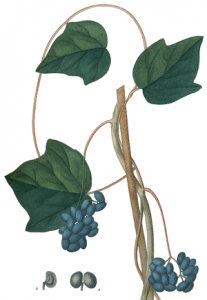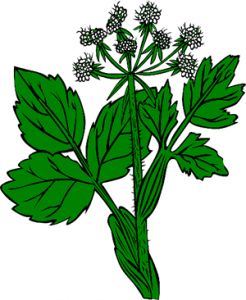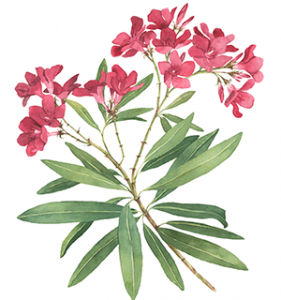These Survival Plants Might Get You Killed
In any survival situation, the most important thing is finding food.
While you may have a stockpile stored safely somewhere, it might not be accessible. Depending on the circumstances, you may find yourself having to forage for food to survive.
Foraging for food is an essential part of any survival plan. It will be vital during a crisis. Most forested areas are rich with edible plants. These plants can potentially hold you over until you can reach your safe house.
However, many wild plants can be dangerous. Some are even perfect replicas of the original. Knowing which plants are safe to eat and which are not is critical to survival.
Below are a few plants that you do not want to eat when aiming to survive in the wild.
Moonseed
 Menispermum canadense – also known as Moonseed. This is a woody vine that grows 8’-20′ long. Stems of the young plant are green to brownish-red and slightly hairy, while older ones become hairless and woody. The smooth leaves of this plant are 6″ long and 8″ across and often bend downwards.
Menispermum canadense – also known as Moonseed. This is a woody vine that grows 8’-20′ long. Stems of the young plant are green to brownish-red and slightly hairy, while older ones become hairless and woody. The smooth leaves of this plant are 6″ long and 8″ across and often bend downwards.
Clusters of white or yellowish flowers sometimes appear along the non-woody stems of these plants and may reach up to 5″ in length.
This plant blooms in late spring to early summer and lasts about two weeks.
Female flowers will develop into small berries in late summer to early fall and look similar to wild grapes.
Found throughout North America, this plant commonly grows within the region and is native to Illinois.
A low-lying vine plant, Moonseed has a high poison severity and is highly toxic to humans – causing convulsions and death when ingested. The toxic principle of this plant, Alkaloid dauricine, is found in all the plant parts.
Thankfully, this plant’s highly potent berries have a rank taste – which often deters hungry foragers.
However, because this plant’s leaves and fruit are similar to Fox Grapes- which are edible, this resemblance leads to them being confused as Fox Grapes or Wild Grapes and unknowingly consumed.
Unfortunately, Moonseed is highly poisonous and can be fatal if eaten.
While this plant’s flavor is usually enough to indicate danger, one should always examine the fruit’s seeds when foraging to ensure it is not a moonseed.
Moonseeds have a single crescent-shaped seed, while a grapes seed will be round. The tendrils of this plant are also an indication. Grapevines will have forked tendrils, where Moonseed vines lack tendrils altogether.
Signs and symptoms of Moonseed poisoning may include:
- Confusion
- Diarrhea
- Dizziness
- Difficulty breathing
- Irregular heart rate
- Stomach pain
- Vomiting
- Nausea
- Pupil changes
- Cardiac arrest
- Weakness or paralysis
- Seizures
*If Moonseed is consumed, it is suggested that you seek immediate medical attention to rid your body of the deadly toxins and treat any related symptoms.
Snakeroot
 White snakeroot plants have coarse toothed, round-based leaves with pointed tips and can reach up to 3 feet (1m) in height—clusters of flowers grown on the top of the stem throughout summer and fall.
White snakeroot plants have coarse toothed, round-based leaves with pointed tips and can reach up to 3 feet (1m) in height—clusters of flowers grown on the top of the stem throughout summer and fall.
This plant prefers shady areas and is commonly found along roadsides, in thickets, or under powerlines.
The leaves and stems of the white Snakeroot contain tremetol. This fat-soluble toxin is known to poison the livestock consuming it and passes into lactating animals’ milk.
The name of this plant was derived from the belief that this plant’s roots could cure snake bites.
It was also thought that burning this plant could revive an unconscious person. Thus it has been used medicinally for many years. However, due to its toxicity, even the medicinal use of Snakeroot is not recommended.
While consuming this plant is not often deadly to humans, it can cause ‘milk sickness’. The poisonous properties of this plant are most significant when the plant is fresh and green.
However, even dried versions of this plant have been found to contain toxins. This plant is especially toxic to animals, with death occurring when an aminal eats anywhere from 1%-10% of their body weight over a few weeks.
Signs and symptoms of Milk sickness (also known as tremetol vomiting):
- Trembling
- Vomiting
- Severe intestinal pain
*Milk sickness caused by Snakeroot does not rely on personal ingestion. Milk sickness can occur when consuming animal products from an animal that has come into contact with or ingested this plant.
Pokeweed (aka wild parsnips/carrots)
 Phytolacca americana, or pokeweed, is native to eastern North America and the mid-west but is scattered throughout Canada, the United States, Europe, and Asia.
Phytolacca americana, or pokeweed, is native to eastern North America and the mid-west but is scattered throughout Canada, the United States, Europe, and Asia.
Considered a pest weed by farmers, pokeweed is poisonous to humans, dogs, and livestock.
While this plant is edible in the spring season with proper preparation, it later becomes deadly.
Cultivating poisonous berries can induce vomiting, burning sensations, altered heart rate, respiratory issues, convulsions, and even death if ingested.
All parts of this plant can be toxic and pose a risk to humans if eaten. The poison, produced by the chemicals phytolaccatoxin and phytolaccigenin, is most concentrated in the roots, stems, and leaves of this plant.
However, the berries should also be avoided as they still contain enough toxicity to cause harm.
Pokeweed can be identified by its large, fleshy, white taproot that often grows 4 to 6 inches in diameter. The stems of this deadly flora can grow 3 to 7 feet tall in some areas and are typically a deep reddish-purple. Whiteish-green flowers adorn this plant and consist of 5 petal-like, rounded leaves that mimic flower petals, growing in clusters opposite leaves.
Each flower-like structure develops into 8-10 juicy berries that are flat and round in shape and small in size. The berries begin as a light shade of green, turning black or purple, and generally become heavy, drooping with maturity. Each berry contains a small, black lens-shaped seed encased in a juicy blood-colored liquid.
Native Americans used pokeweed to treat a variety of conditions in the past, and juice from the berries was often used to create red dye.
Signs and symptoms of Pokeweed poisoning include:
- Diarrhea, sometimes hemorrhagic (bloody) diarrhea
- Stomach pain
- Nausea and vomiting
- Weakness
- Muscle spasms
- Convulsions
- Seizures
- Headache
- Heart block
- Rapid pulse
- Low blood pressure
- Slow or difficult breathing
*Other names for Pokeweed poisoning include American nightshade poisoning; Inkberry poisoning; Pigeon Berry poisoning; Pokeberry poisoning; Scoke poisoning; Virginia poke poisoning; Poke salad poisoning.
Treatment
Poisoning from pokeweed requires immediate medical attention.
However, suppose you cannot get to an emergency room. In that case, you could attempt to create activated charcoal by burning wood or another dense plant fiber until everything but the carbon has been scorched away.
Unfortunately, this process can take several hours, and you need to mix the charred wood with other chemicals to create a useful substance. Thus, this may be challenging in a survival situation, and it is best to seek professional medical help.
*If you or someone you know has consumed pokeweed, call poison control, or immediately go to the nearest emergency department.
Belladonna or Deadly Nightshade
 Atropa belladonna – commonly referred to as Belladonna or Deadly Nightshade– is a poisonous perennial herbaceous plant in the nightshade family.
Atropa belladonna – commonly referred to as Belladonna or Deadly Nightshade– is a poisonous perennial herbaceous plant in the nightshade family.
Found in various places in Europe, Northern Africa, and Western Asia, it is also scattered throughout Canada and the United States.
This plant’s foliage and berries are extremely toxic if ingested because of the chemical (tropane alkaloids) they contain.
Bella Donna is one of the most poisonous plants known to man, and its effects can be deadly.
All parts of this plant contain tropane alkaloids. The leaves are most poisonous when the plant is budding or flowering, and the roots are most toxic at the end of the vegetation period.
However, this plant’s berries pose the greatest danger because they look delicious and have a somewhat sweet taste.
Despite its name, which means ‘beautiful lady,’ the Belladonna plant is exceptionally hazardous. Poisonous to humans and most animals, Belladonna poisoning affects the nervous system.
Symptoms may include:
- Dry mouth
- Red, dry skin
- Inability to sweat
- Muscle spasms
- Blurred vision
- Enlarged pupils
- Hallucinations
- Inability to urinate
- Seizures
- Convulsions
- Death
- Coma
Belladonna is commonly used as an ingredient in many over-the-counter medications to treat many common ailments.
For example, belladonna can be found in treatments for
- common cold
- fever
- whooping cough
- each ache
- asthma
- motion sickness
- flu
- joint and back pain
- inflammation
- nerve issues.
Unfortunately, belladonna can have serious side effects, especially when consumed without medical advice.
*If consumed, seek medical attention immediately. Activate charcoal is used to remove toxins from the body, and treatment of the various symptoms is often required.
Rhododendron
 Found throughout most western and eastern United States, this plant is easily mistaken for bay leaves. Unfortunately, using these leaves to spice up your emergency stew would be a bad idea.
Found throughout most western and eastern United States, this plant is easily mistaken for bay leaves. Unfortunately, using these leaves to spice up your emergency stew would be a bad idea.
Rhododendron and Azaleas are close relatives and cause the same types of toxicity. It is often referred to as ‘mad honey’. Because the honey found in this plant’s flowers is known to cause confusion. So eating any part of this plant is discouraged.
Poison control often receives calls in spring and early summer about children who have put the flowers or leaves in their mouths trying to eat them.
While this plant generally only causes mild mouth irritation, nausea, and vomiting have also been known to occur with ingestion. While rare, severe and life-threatening poisoning has occurred. Thus, this plant should not be consumed.
The honey of this plant holds the highest concentration of poison. The agent responsible for the poisoning properties of this plant is Grayanotoxin.
The neurotoxin, which is also known as andromedotoxin, acetylandromedol, rhodotoxin and asebotoxin, is produced within rhododendron and other plants within the Ericaceae or Heather family. Honey made from the nectar also contains grayanotoxin – or ‘mad honey.’
Mad Honey poisoning can occur anywhere from a few minutes to a few hours after ingestion and symptoms include:
- Salivation
- Vomiting
- Circumoral paralysis (around or near the mouth)
- Low blood pressure
- Low heart-rate
- Loss of coordination
- Progressive muscle weakness
- Gastrointestinal issues
- Dizziness
- Loss of balance
- Difficulty breathing
*Rhododendron poisoning is rarely fatal to humans, and symptoms usually last less than 24 hours. Death is much more common among animals who ingest this plant while grazing.
Treatment:
Treatment requires vomiting-inducing techniques and repeated use of activated charcoal. If you ingest Rhododendron, seek medical attention as soon as possible.
While obtaining plants for survival may be dangerous, you can often find danger in your own backyard as well.
Plants that commonly grow in urban areas can be just as harmful to your health as those found out in the wild.
For example, rhubarb leaves are known to be extremely poisonous, and while this plant is known to many as a tasty treat, the leaves may cause severe medical issues if consumed.
Rhubarb poisoning can cause:
 Breathing difficulty
Breathing difficulty- Burning in the throat
- Coma
- Eye pain
- Kidney stones
- Nausea
- Red-colored urine
- Seizures
- Stomach pain
- Vomiting
- Weakness
In the wild, there are many plants available for survival.
Unfortunately, there are also many that can cause damage or even death if consumed unknowingly. It is vital that you are aware of what you are eating and sure that it is safe.
Being aware of your surroundings and knowing which plants (or which parts of plants) are safe to consume may mean the difference between life and death.
Not all plants are man's best friend. Surviving also means knowledge. For example, These Survival Plants Might Get You Killed

